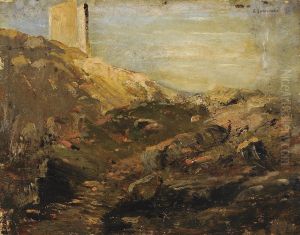Serafino De Avendano Paintings
Serafino De Avendano was an Italian painter born in Naples in 1837. He belonged to the 19th-century school of Neapolitan painting, which was characterized by its vivid realism and attention to detail, as well as an often romantic or picturesque quality in its depiction of both everyday life and historical subjects. De Avendano's work, while not as widely recognized today as some of his contemporaries, contributed significantly to the Italian art scene of his time, reflecting the cultural and social currents of 19th-century Italy.
De Avendano's artistic journey was marked by a rigorous academic training. He studied at the Academy of Fine Arts in Naples, a city with a rich artistic tradition that deeply influenced his development as a painter. The Academy was a center for the study of both classical art and the vibrant Neapolitan painting tradition, providing De Avendano with a solid foundation in the techniques and themes that would dominate his work. Throughout his career, he explored a variety of subjects, including historical scenes, landscapes, and portraits, displaying a versatility and depth that resonated with both the public and critics of his time.
During his lifetime, De Avendano's work was exhibited in several important Italian art shows, including those in Turin and Milan, helping to establish his reputation beyond his native Naples. His paintings were appreciated for their detailed execution, masterful use of color, and the ability to capture the essence of his subjects with both realism and sensitivity. Despite this, De Avendano has not maintained the same level of fame as some of his peers, such as Domenico Morelli or Filippo Palizzi, and his work is today less known to the general public.
Serafino De Avendano died in 1894, leaving behind a body of work that, while perhaps overlooked in the broader narrative of 19th-century Italian art, offers a fascinating insight into the era's artistic movements and the regional specificity of Neapolitan painting. His paintings, when they do surface in art auctions or exhibitions, are valued for their contribution to the understanding of this period in Italian art history and for their exquisite craftsmanship and beauty.

